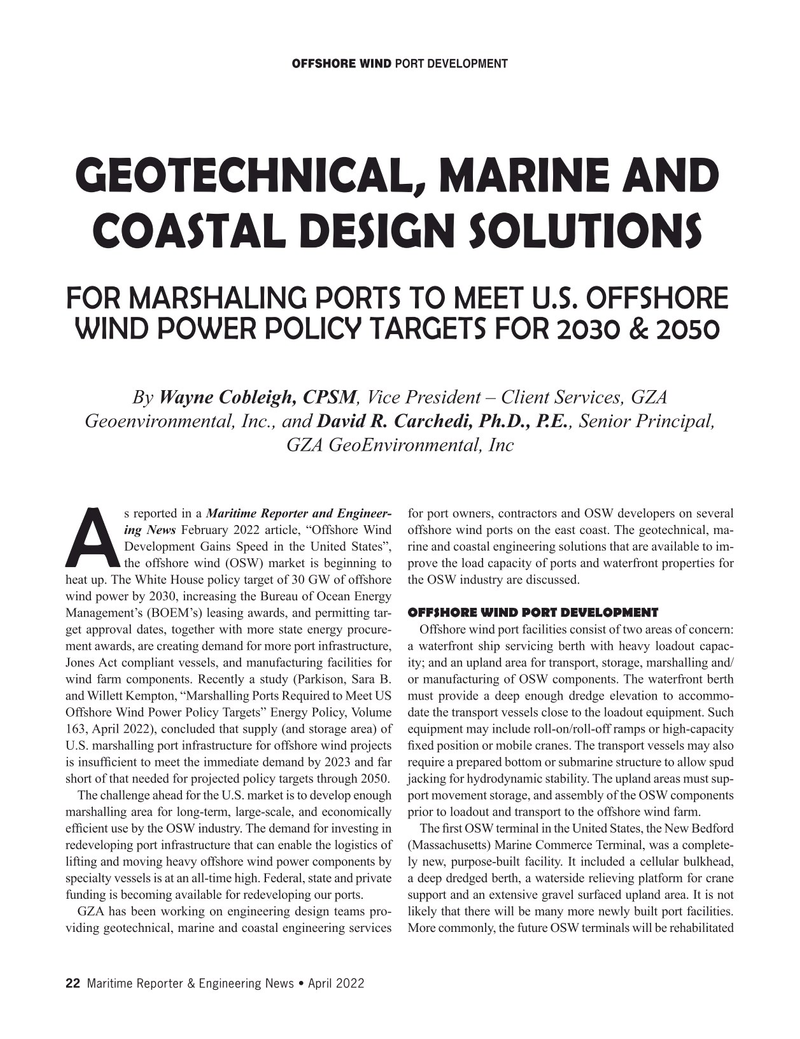
Page 22: of Maritime Reporter Magazine (April 2022)
Offshore Energy
Read this page in Pdf, Flash or Html5 edition of April 2022 Maritime Reporter Magazine
OFFSHORE WIND PORT DEVELOPMENT
GEOTECHNICAL, MARINE AND
COASTAL DESIGN SOLUTIONS
FOR MARSHALING PORTS TO MEET U.S. OFFSHORE
WIND POWER POLICY TARGETS FOR 2030 & 2050
By Wayne Cobleigh, CPSM, Vice President – Client Services, GZA
Geoenvironmental, Inc., and David R. Carchedi, Ph.D., P.E., Senior Principal,
GZA GeoEnvironmental, Inc s reported in a Maritime Reporter and Engineer- for port owners, contractors and OSW developers on several ing News February 2022 article, “Offshore Wind offshore wind ports on the east coast. The geotechnical, ma-
Development Gains Speed in the United States”, rine and coastal engineering solutions that are available to im-
A the offshore wind (OSW) market is beginning to prove the load capacity of ports and waterfront properties for heat up. The White House policy target of 30 GW of offshore the OSW industry are discussed. wind power by 2030, increasing the Bureau of Ocean Energy
Management’s (BOEM’s) leasing awards, and permitting tar- OFFSHORE WIND PORT DEVELOPMENT get approval dates, together with more state energy procure- Offshore wind port facilities consist of two areas of concern: ment awards, are creating demand for more port infrastructure, a waterfront ship servicing berth with heavy loadout capac-
Jones Act compliant vessels, and manufacturing facilities for ity; and an upland area for transport, storage, marshalling and/ wind farm components. Recently a study (Parkison, Sara B. or manufacturing of OSW components. The waterfront berth and Willett Kempton, “Marshalling Ports Required to Meet US must provide a deep enough dredge elevation to accommo-
Offshore Wind Power Policy Targets” Energy Policy, Volume date the transport vessels close to the loadout equipment. Such 163, April 2022), concluded that supply (and storage area) of equipment may include roll-on/roll-off ramps or high-capacity
U.S. marshalling port infrastructure for offshore wind projects ? xed position or mobile cranes. The transport vessels may also is insuf? cient to meet the immediate demand by 2023 and far require a prepared bottom or submarine structure to allow spud short of that needed for projected policy targets through 2050. jacking for hydrodynamic stability. The upland areas must sup-
The challenge ahead for the U.S. market is to develop enough port movement storage, and assembly of the OSW components marshalling area for long-term, large-scale, and economically prior to loadout and transport to the offshore wind farm. ef? cient use by the OSW industry. The demand for investing in The ? rst OSW terminal in the United States, the New Bedford redeveloping port infrastructure that can enable the logistics of (Massachusetts) Marine Commerce Terminal, was a complete- lifting and moving heavy offshore wind power components by ly new, purpose-built facility. It included a cellular bulkhead, specialty vessels is at an all-time high. Federal, state and private a deep dredged berth, a waterside relieving platform for crane funding is becoming available for redeveloping our ports. support and an extensive gravel surfaced upland area. It is not
GZA has been working on engineering design teams pro- likely that there will be many more newly built port facilities. viding geotechnical, marine and coastal engineering services More commonly, the future OSW terminals will be rehabilitated 22 Maritime Reporter & Engineering News • April 2022
MR #4 (18-33).indd 22 4/5/2022 9:47:36 AM

 21
21

 23
23
